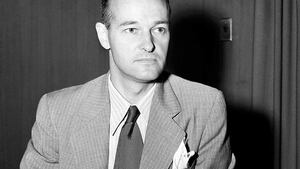George Frost Kennan, father of the ingenious strategy of containment that prevailed in Cold War I, had an absolutely uncanny ability to peer into the heart of Russian history and politics. Much of what he saw about Russian civilization he admired, but he also saw that for centuries the nation’s leaders had displayed a deep sense of insecurity over relations with foreign powers, leading them to mount recurring drives to expand Moscow’s power at the expense of all potential rivals and neighbors. Interestingly, Kennan was also one of the most articulate critics of the West’s strategies for dealing with the Kremlin, both during the Cold War and after it ended with the fall of the Soviet Union in 1991.
The lanky diplomat-scholar wouldn’t have been very surprised by Russia’s three-pronged conventional invasion of Ukraine last month, with the main effort being directed at decapitating the duly elected government of Volodymyr Zelensky. Indeed, America’s most influential student of Russian history and politics in the 20th century predicted that real trouble would rise up again between Russia and the West, if the Western alliance ignored Russia’s legitimate security concerns while letting military deterrence against Russian expansion weaken.
Both of those developments, of course, have now come to pass.
As far back as 1997, Kennan wrote in his diary, “I have been rendered most unhappy by the admission of Poland, the Czech Republic and Hungary to membership in NATO.” How was such a development “to be reconciled with the assurances to the Russians that they need not worry, that the extension of NATO’s borders to the east has no military implications?” Kennan saw nothing in the rapid and reckless expansion of NATO “other than a new Cold War, probably ending in a hot one, and the end of the effort to achieve a workable democracy in Russia.”
Kennan also believed firmly that if the West failed to respond with counterforce, resolve, and a unanimous voice to Russia’s deeply ingrained expansionist tendencies, Moscow would surely attempt to challenge Western encroachment on territory it saw as falling within its rightful sphere of influence. “The Kremlin, he wrote as early as 1946, “has no compunction about retreating in the face of superior force.” Indeed, deterrence was an essential element of his concept of containment. As Kennan said again and again during the Cold War, Western policymakers needed to be absolutely clear about their red lines, and to back them up with credible threats of military force.
Although he’s been dead since 2005, it’s a good bet Kennan would see Moscow’s decision to launch a full-throated invasion of Ukraine as a result of both sides’ failure to respond creatively with diplomacy to address Russia’s security concerns, and a failure on the part of the United States and Europe to establish a credible deterrent to Russian expansionism at the point of a gun.
By the late 1990s, Kennan had been studying U.S.-Russian relations for well over half a century. And he had shaped the course of those relations profoundly. As the No. 2 man in the American embassy in Moscow in the waning days of World War II, Kennan waged a lonely crusade to persuade his superiors, especially the ailing Franklin Delano Roosevelt, to remove their rose-colored glasses and see Russia for what it was, not what they wished it to be.
Stalin had proved an indispensable ally, the conventional thinking in the FDR administration went. Surely he intended to honor his commitments to respect the freedom and self-determination of all peoples in shaping the postwar world, regardless of Marxism’s doctrinal hostility to democratic capitalism? Surely he should be dealt with in a spirit of cooperation, and granted massive American aid for reconstruction, along with the other allies? Well, it took about a year after the war ended in Europe for those illusions to be put to rest.
Kennan did more than any other individual to bury them. On Feb. 22, 1946, not long after Stalin’s “iron curtain” had descended over Eastern Europe, Kennan fired off to Washington the longest telegram in American diplomatic history, up to that point. In 5,000 words, with laser-like precision, he described the nature of postwar Soviet foreign policy, locating its sources deep in imperial Russia’s long history of expansionism and paranoia about the intentions of foreign powers. Then—as if that wasn’t enough for one telegram—he proceeded to lay out a brilliantly conceived counter-strategy for the United States.
Stalin, said Kennan, would paint the capitalist West out to be an implacable enemy of Russia, bent on its humiliation and destruction. He was deeply hostile to the West, especially the United States. “We have here [in the Kremlin],” wrote Kennan, “a political force committed fanatically to the belief that with the US there can be no modus vivendi, that it is desirable and necessary that the internal harmony of our society be disrupted, our traditional way of life destroyed… if Soviet power is to be secure.”
Nonetheless, there was reason for optimism. The new Soviet empire in Eastern Europe was composed of proud and talented peoples who would not submit to Soviet domination forever. Marxism was a doctrine of alluring but false promises. Taken all together, the Soviets possessed a lousy political system. In time, it would inevitably collapse of its own weight.
In view of these realities, said Kennan, the United States and its allies “must pursue a policy of long-term, patient, but firm and vigilant containment of Russian expansive tendencies” through “the adroit and vigilant application of counterforce at a series of continually shifting geographical and political points.”
The “Long Telegram” changed everything, and fast. Everyone involved in American foreign policy read it. Virtually everyone, and certainly Harry Truman, believed it. In a matter of a few months “containment” became the master American strategy for waging the Cold War. And so it remained for the next 45 years. Only after the collapse of the Soviet Union in 1991 did the prophetic brilliance of Kennan's ideas come fully into view. Just as Kennan predicted, the Soviet Union had imploded. Democratic capitalism had won the Cold War not with a bang, but a whimper.
In its hostility to the United States, Western Europe, and democratic ideas and institutions, Putin’s foreign policy bears an uncanny resemblance to that of his Soviet forebears, stripped of its communist ideology. At the heart of Putin’s view of world affairs is what Kennan called “Russia’s traditional and instinctive sense of insecurity… They have always feared foreign penetration, feared direct contact between the Western world and their own, feared what would happen if Russians learned the truth about the world within. And they learned to seek security only in the patient but deadly struggle for… destruction of rival power, never in compacts or compromises with it.”
Vladimir Putin, former senior KGB officer, has famously said that the demise of the Soviet Union was the biggest catastrophe of the 20th century, and he has been working assiduously for 22 years to restore Russia’s status as a great power. Without question, he has made great strides.
Under Putin, the Russian state had developed a formidable capacity to integrate multiple instruments of hard and soft power in pursuit of its goals, often at the expense of the United States and NATO. “Hybrid warfare” is perhaps the best name for the Kremlin’s current approach to conflict. It combines conventional military operations and military intimidation, political front movements, multi-media propaganda campaigns, fake news, cyberwarfare, and traditional diplomacy.
The Russians now possess formidable conventional forces, tailor-made for operations in Eastern Europe. The Russian Army’s most ominous capability in the eyes of NATO’s command may well be in air defense. Its “anti-access/area denial” (A2/AD) systems are very robust and getting more sophisticated all the time. Western forces have come to take air superiority for granted wherever they deploy. In a war against Soviet forces, this wouldn’t necessarily be the case. According to the U.S. Army’s Russian New Generation Warfare Handbook, “Russia uses a very dense network of air-defense systems that overlap in layers to increase their protective capabilities. Gaps in coverage can… be filled by new [electronic warfare] systems that confuse incoming missiles… or cause premature detonation of electronic fuses.”
While the Western media see Putin’s decision to wage all-out war against Ukraine as an outrageous affront to both the rules-based international order and Ukrainian sovereignty, Putin sees the rules-based order as rigged against Moscow’s legitimate interests and Western powers as unwilling to address Russian security concerns over NATO, the world’s largest military alliance by far. His most pressing concern is clearly Ukraine’s slow but unmistakable slide toward the West, a slide that has picked up considerable steam ever since the Russian annexation of Crimea in 2014. It is that slide that Putin is determined not only to halt, but to reverse.
Kennan would be highly critical of the West’s—and particularly Washington’s—piecemeal and reactive responses to Putin’s grievances, both real and imagined, over the last several years. He would understand that Putin, like his Soviet and Czarist predecessors, would act with restraint only in the face of credible threats of force, not the bluster, bombast, and largely ineffective sanctions against Moscow in the wake of its annexation of the Crimea and its support for the Russian separatist minority in eastern Ukraine. The biggest land grab of the post-Cold War era in Europe resulted in little more than a wrist slap for the Russian strongman.
As Chris Miller, a professor of international politics at the Fletcher School, wrote in a recent essay in The New York Times, “There is no world leader today with a better track record when it comes to using military power than… Putin. Whether against Georgia in 2008, Ukraine in 2014, or in Syria since 2015, the Russian military has repeatedly converted battlefield successes into political victories.” Putin’s chief adversary—the United States of America—has a much more extensive record of using military force to achieve its ends since the end of the Cold War than Russia does. Trouble is, it has usually failed to obtain its objectives, and failed big.
Putin recognizes that today, the United States is a war-weary, overextended superpower, attempting to pivot the bulk of its military forces to the Indo-Pacific region to deter China. He knows that the Europeans have grown soft and comfortable under the American security umbrella. He does not believe that the West is willing to make concessions through diplomacy. And so he has decided to get what he wants in a way that has worked very well for him to date: military force.





